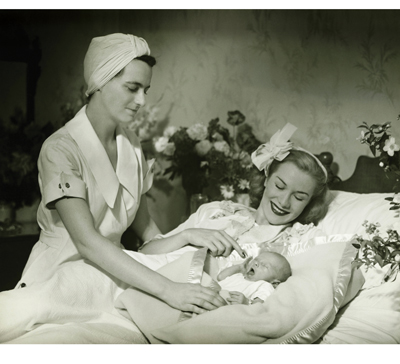Not your grandmama's pregnancy
The [arguably] good old days If you found yourself expecting […]

If you found yourself expecting a baby in the 19th century, you might view your condition with limited enthusiasm. Of course, you would hope for a healthy child and a happy future, but precedent would give you cause for major concern. Chances are, you would know of women who had died in childbirth, most likely of puerperal fever (now recognized as a bacterial infection brought on by doctors with unwashed hands or contaminated medical equipment).
Birth experiences were unofficially divided by class in the 1800s: Poor people and rural types hired midwives to coach them through home births while the bourgeoisie and social upper crust employed doctors and increasingly gravitated toward hospitals for labor and delivery. Ironically, hospitalization was often less hygienic than home birthing, offering naïve mothers a greater chance of infection. Before germ theory was accepted by the medical community, hospital staff went from patient to patient, or from cadaver to patient, without washing hands or instruments. Disease was spread with deadly results.
Shot in the dark
Fast forward to the mid-20th century, and birthing seems a lot less menacing. Hospitals had become sanitary environments where women could expect to receive adequate care, although moms-to-be were seldom informed of just what that care would entail. Baby’s state in the womb also remained elusive. Without ultrasounds or prenatal testing, baby’s health and sex were anyone’s guess. Women approached delivery unsure of what lay ahead, even if they had delivered previously. Upon arrival at the hospital, they would be shaved, given an enema, and drugged. Options and explanations weren’t typically offered. In this age of anesthesia, a laboring woman was either gassed with ether or injected with “twilight sleep”—a mix of morphine (for the pain) and scopolamine (to produce a temporary amnesia). Childbirth was a blur, a fuzzy memory at best.
Some sedated women reacted with semiconscious violence, thrashing and screaming from the hospital bed, so they were routinely strapped down for the birth. Tina Cassidy, author of Birth: The Surprising History of How We Are Born, states, “Men were not allowed to witness childbirth in American hospitals for the most part until the 1970s.” With papa in the waiting room and mom in a seminarcotic daze, the hospital staff would be the only witnesses to delivery, which typically included extraction with forceps. When the bewildered new mama came to, she’d be handed a bundled-up baby and a bottle of formula.
Pregnancy and the modern mom
In response to the drugged stupor of 1950s to 1960s births, the 1970s reintroduced natural birthing. Lamaze became popular. Prenatal yoga first appeared in the Western world. Expectant moms were encouraged to live healthy, normal lives. Riding the wave of the feminist movement, there was a push to view pregnant women as strong and capable, not unwell. And for the first time since birth moved to hospitals, men were let out of the antechamber and into the delivery room.
When What to Expect When You’re Expecting came out in 1984, moms-to-be studied it like scripture, eager to learn more about what their bodies were going through. Prenatal testing, and the advent of amniocentesis (mid-1970s) and chorionic villus sampling (early 1980s), provided more clues to a woman’s pregnancy specifics.
With each passing decade, the medical community attains more knowledge about pregnancy and birth; thus, 21st-century pregnancies involve less guesswork than those of yesteryear. If you elect to pursue the standard OB/GYN timeline, you will receive routine testing for mom and baby so that, ideally, complications can be predicted and addressed before birth.
Ultrasounds have come a long way even since the ’80s and ’90s. An in-office scan can now reveal much about baby’s condition and—at least by 20 weeks—indicate his sex. Birthing classes and hospital tours can give you a good idea of what labor and delivery entails, so you can plan the specifics of your hospital experience. Then it’s baby showering, nursery designing, layette shopping … there’s an air of excitement (and spending!) surrounding modern pregnancies.
What’s next?
For pregnancy
Women are more active during pregnancy than they used to be. Many of us remain in force at work and at the gym right up until delivery, unless complications put us on bed rest. This is likely to continue in the future—driven moms will push themselves to “do it all,” even while pregnant, whenever possible.
For birth
“Natural home births are among the latest trends as demonstrated by celebrities Gisele Bundchen, Jessica Alba and Kourtney Kardashian,” observes Amy Spangler, MN, RN, IBCLC, president of baby gooroo, inc. “Water-assisted labor is also growing in popularity.” With the cultural trend of “going green” and embracing natural solutions, midwifery is regaining favor in the U.S. We’re likely to see a decrease in elective C-sections and inductions, along with other medical interventions. On the other hand, for those in higher-risk scenarios, technology is constantly advancing and allowing for “miracle births” we never thought possible. C-sections and NICU care have saved many lives and will continue to do so.
Dressing the bump
From shameful to chic, Victorian folk referred to pregnancy as “confinement”—women hid their bellies under flowing fabrics and shared their news with only the closest family and friends. Then Lane Bryant created the first maternity clothes in 1904, and while many of her customers preferred to order by mail rather than publicize their “condition” on Fifth Avenue, it quickly became obvious that maternity clothes were in demand.
Over the decades, the American public has become more and more accepting of baby bumps. Baggy A-line blouses and oversized frocks have, thank heavens, given way to form-fitting tops and dresses that accentuate a round belly rather than disguise it. The pregnant silhouette is now seen as beautiful, so we can hope to be embraced for, not embarrassed about, our shape. We can purchase maternity lingerie, pose for prenatal photos, and walk the beach in a bikini, proudly sporting a round tummy.
How did our culture come to admire maternal bellies? It hasn’t hurt to have sexy celebrities showing off their prenatal physiques. So thank you, Demi Moore, for posing nude (and very pregnant) on the cover of Vanity Fair. Thank you, Heidi Klum, for looking hot and curvy on the red carpet, even in your third trimester. And thank you too, Tori Spelling, for being pregnant and proud of it in front of the world. Y’all make pregnancy look good!







